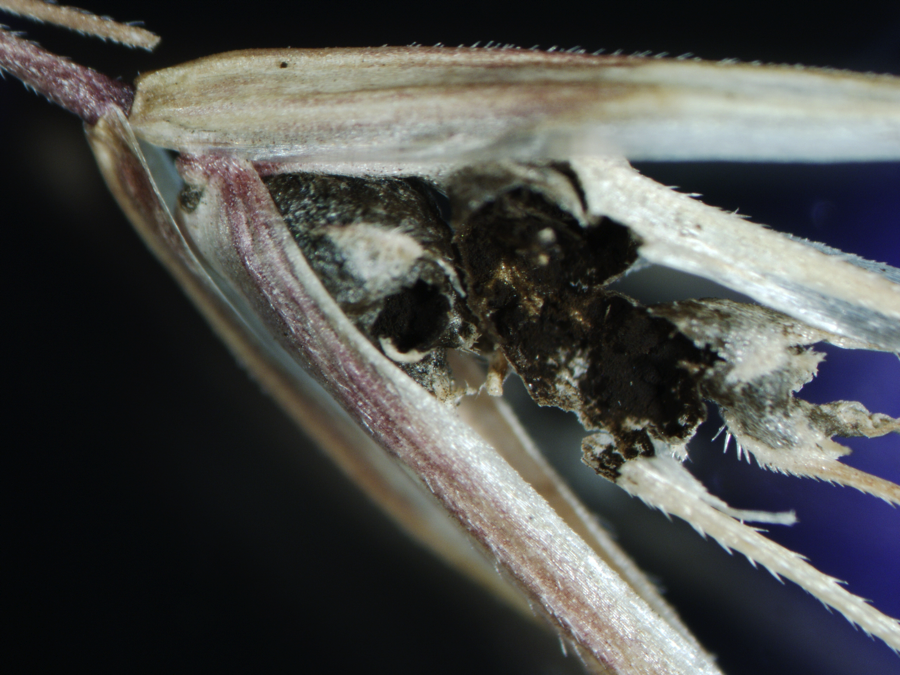
Stacia Hill Cleans Up at the Butte Science Fair
Block title
 By: Ylva LekbergPh.D. Ecologist
By: Ylva LekbergPh.D. EcologistStacia Hill, a Big Sky High School student, has worked with MPG for 2 years to investigate a naturally occurring cheatgrass pathogen. She used molecular techniques to identify this pathogen as the fungus Ustilago bullata and conducted field surveys to estimate its abundance on the ranch. In the fall of 2011 she examined the ability of Ustilago to control cheatgrass, the most abundant plant on MPG Ranch.
Stacia’s research has been very fruitful. She recently swept the awards presented at the Butte Regional Science Fair, including best of show in the Biological Sciences and first place overall. This accomplishment earned her a trip to the International Science and Engineering Fair in Pittsburgh this May. On behalf of everyone at MPG Ranch, we want to congratulate Stacia for her amazing achievements and wish her the best of luck in upcoming competitions!

Photo 1. Stacia estimates the Ustilago bullata abundance in a cheatgrass invasion on MPG Ranch.

Photo 2. Ustilago-infected cheatgrass with millions of spores instead of seeds, which eliminates the seed production of this invasive annual grass.

About the AuthorYlva Lekberg
Ylva graduated from the Swedish University of Agricultural Sciences with a M.Sc. in Biology and Horticulture in 1996 and a Ph.D. in Ecology from Penn State University in 2004. She received the Alumni Association Dissertation Award for her work in agroecology and subsistence farming in Sub-Saharan Africa. Post-doctoral positions at Montana State University and later at Copenhagen University as a Marie Curie Fellow allowed her to explore the role of arbuscular mycorrhiza, a root-fungus symbiosis, for geothermal plants in Yellowstone National Park and coastal grasslands in Denmark. Her research has been published in international journals such as Nature Communications, Ecology Letters, and New Phytologist.
Ylva joined MPG Ranch in 2010. Since then, she has explored how invasive plants common to western Montana, including spotted knapweed (Centaurea stoebe), leafy spurge (Euphorbia esula) and cheatgrass (Bromus tectorum), influence soil microbial community composition and function, and how this in turn may affect invasive success. A lot of her research also focuses on the AM symbiosis in terms of community ecology and physiology. A current project addresses how exchange ratios in this symbiosis may differ among co-occurring plants and depend on soil nutrient availabilities. She uses surveys, field and greenhouse experiments, and literature approaches such as meta-analyses to address questions. To learn more about research and publications from Ylva and her group, see CV below and the Soils, Plants and Invasion section.
In addition to her work at MPG Ranch, Ylva is an adjunct professor at University of Montana at the Department of Ecosystem and Conservation Sciences.
Ylva joined MPG Ranch in 2010. Since then, she has explored how invasive plants common to western Montana, including spotted knapweed (Centaurea stoebe), leafy spurge (Euphorbia esula) and cheatgrass (Bromus tectorum), influence soil microbial community composition and function, and how this in turn may affect invasive success. A lot of her research also focuses on the AM symbiosis in terms of community ecology and physiology. A current project addresses how exchange ratios in this symbiosis may differ among co-occurring plants and depend on soil nutrient availabilities. She uses surveys, field and greenhouse experiments, and literature approaches such as meta-analyses to address questions. To learn more about research and publications from Ylva and her group, see CV below and the Soils, Plants and Invasion section.
In addition to her work at MPG Ranch, Ylva is an adjunct professor at University of Montana at the Department of Ecosystem and Conservation Sciences.



















